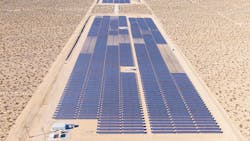Enhancing an aged electric grid to accommodate 21st century energy demands is top of mind for many countries’ governments, and the United States is no exception. The U.S. push toward increased domestic manufacturing, energy independence, and the projected massive investments into electrification (including solar) has led to the construction of utility-grade, industrial, and residential solar farms. However, these large-scale solar projects are running into two primary issues affecting job execution: unpredictable weather (rain, hail, wind, snow, and excessive heat) and the lack of skilled labor (Photo 1).
Unfortunately, these workforce challenges have come at an inopportune time, as solar farm projects are becoming larger and more complex, and, as a result, are requiring more skilled labor than ever before. This creates a vicious cycle. When these challenges are significant enough, projects run behind and put electrical contractors at risk of liquidated assets that erode profit margins. So, how can solar developers and contractors mitigate the unpredictability of Mother Nature and staffing shortages, particularly on large-scale solar projects? Consider pre-assembled solutions.
Manual mishaps and a heated labor force
Pretend it’s 115°F outside (if you spent any time in Arizona this summer, you don’t have to imagine). Workers are outside on the job trying to crimp connectors, assemble combiner boxes, and maneuver large cable reels. Cell phones are so hot they are turning off, and powered equipment is overheating. Given the excessive heat, crews working in pairs can only work in 10-minute increments — 10 minutes on and 10 minutes off in the shade to ensure they don’t overheat (Photo 2). Beyond the 50% productivity loss, these conditions also mean mistakes are more likely to be made — e.g., wire is stripped incorrectly to conductors, a wrong reel is pulled, or the high temperature impacts torque settings on wires, which causes an incorrect torque for connectors.
Heat aside, hand tools used in the field are often not being calibrated consistently, and they can wear down quickly. Manual tools also lend themselves to error, such as a torque tool being too tight, breaking a seal, and letting moisture into the cables. Pre-assembled solutions take the time-consuming and highly critical terminations out of the field, helping to reduce the risk of electrical failures.
If those challenges weren’t enough, finding a skilled labor force to do this work in such conditions is a challenge. While the workers on these large-scale solar farm projects can have high earning potential compared to the industry average, these long, hot days in the field are demanding. By contrast, pre-assembled solutions can decrease the number of skilled professionals needed on a job site because the work was already completed in a warehouse — not out in the field — and shipped directly to the site for faster roll-out.
Benefits of work done in warehouses
Bringing labor out of the field and into the controlled environment of a warehouse helps ensure several things:
In a real-world example, a customer compared two job sites — one that utilized off-site pre-assembly services and the other that conducted a traditional on-site job installation. By leveraging pre-assembled solutions, the customer achieved net savings of 30% and completed the pre-assembled portion of work 60 days ahead of schedule.
Pre-assembled pros and cons
While pre-assembled solutions make sense for several reasons, this approach does take more time upfront. Dialing in engineered final product drawings to match the engineered site plans can require multiple reviews between parties, as well as first articles — all to ensure that pre-assembled solutions meet construction design requirements. While it may be faster to simply order bulk materials, the gain with pre-assembled solutions is in the labor savings and quality of the project. Using pre-assembled solutions, contractors can reduce their labor in the field significantly.
According to a Dodge Data & Analytics SmartMarket report, 90% of contractors say they achieve improved productivity, improved quality, and increased schedule certainty compared with traditional construction methods. Additionally, given the service model of pre-assembled solutions, the costs may be higher upfront, but when factoring in the entire expense of the project with labor included, it can ultimately end up costing less. Operations and maintenance costs can also be reduced.
If your organization is looking to move to pre-assembled solutions, consider engaging with partners early on, and be sure they will stand behind their installations, offer engineering to make the solutions as efficient as possible, communicate about changes along the way, and have a solid QA/QC process in place.
While many of the same physical material components are the same if installed in the field or constructed on pre-assembled solutions, the devil is in the details. This approach is not completely about the products used but rather the process needed to execute a successful project on time and on budget. That element alone can be a distinct competitive advantage.
Sean R. Nacey is senior vice president and general manager, U.S. Construction and Energy Solutions, Wesco.






